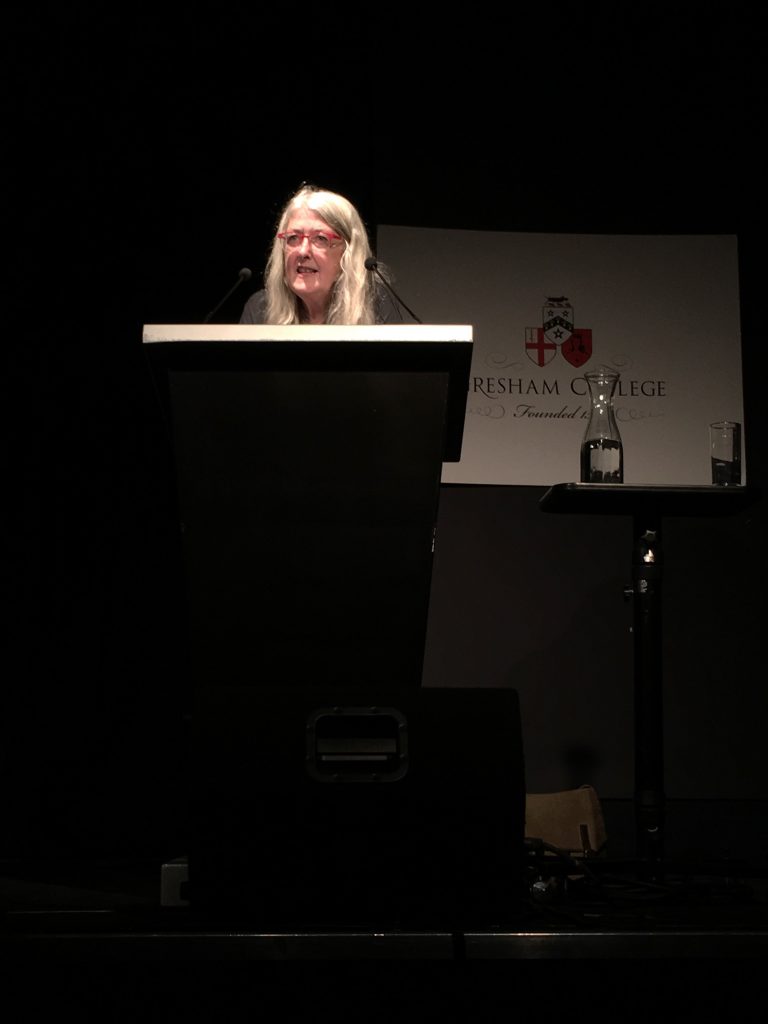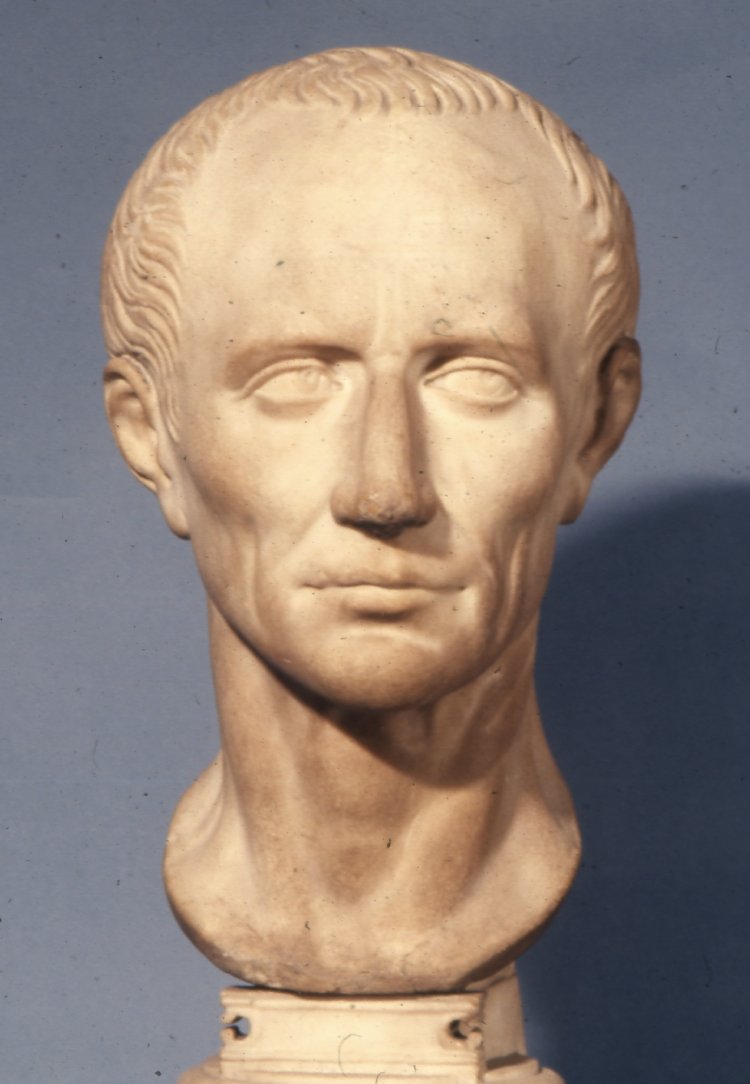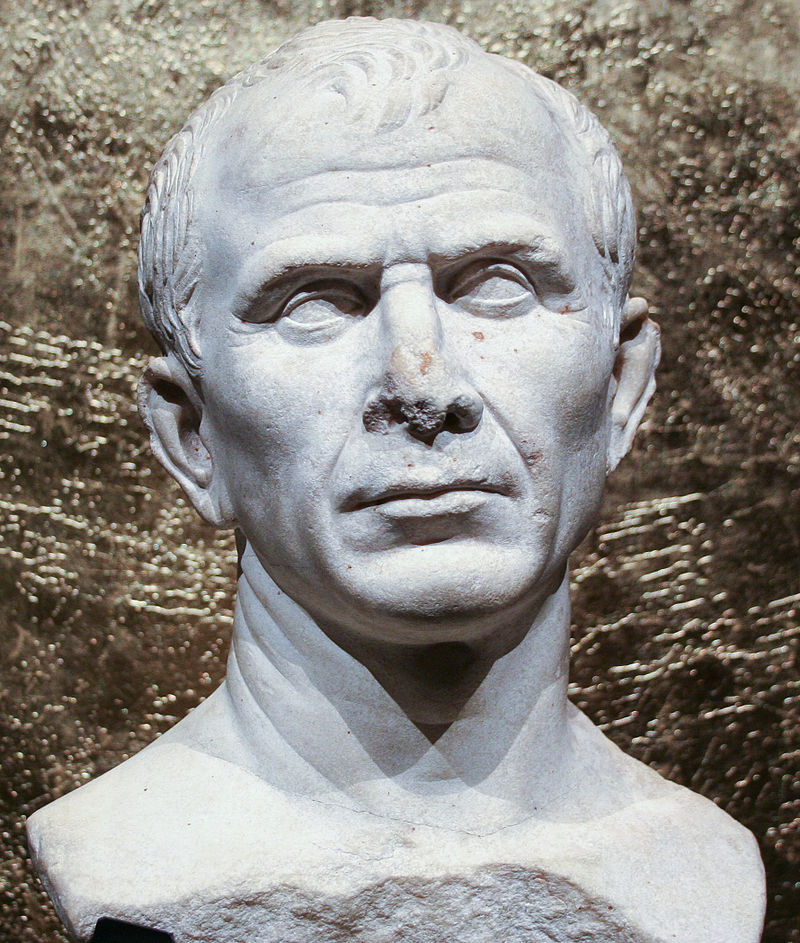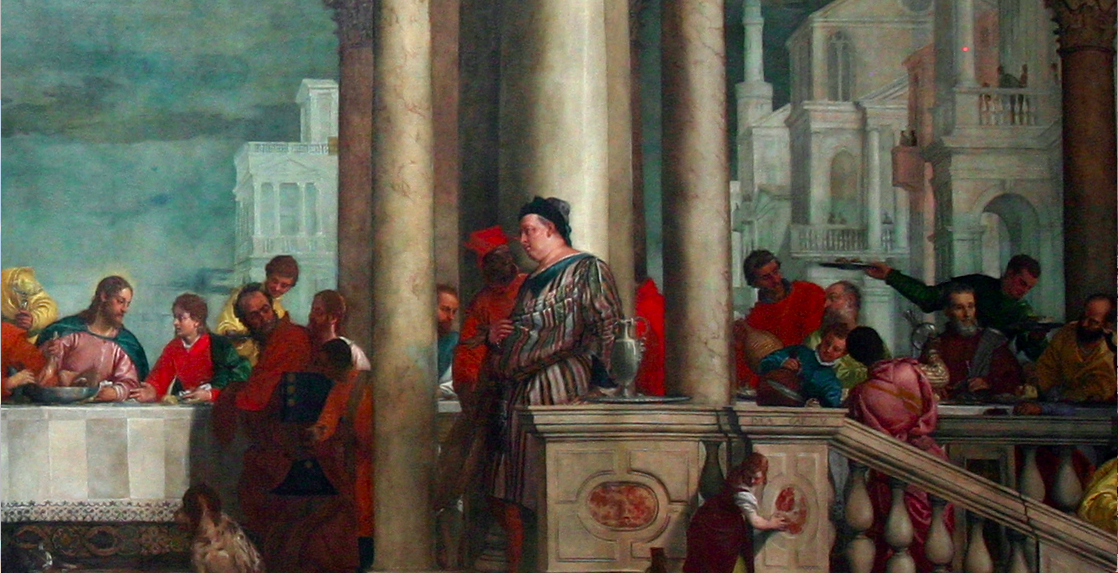“Emperor Spotting” with Mary Beard

Mary Beard giving her talk on How to Spot a Roman Emperor at the Museum of London. Gresham College has been hosting a series of free lectures at the museum. (Photo: Sandra Alvarez)
Last Thursday, Mary Beard gave her talk, “How to Spot a Roman Emperor”, to a packed house at the Museum of London, with people queuing for several hours to hear her speak. The British Classicist and author is famous for her contribution to Ancient Roman scholarship, and for her outspokenness, making her a popular figure with mainstream audiences.
This evening, Beard tried to answer the niggling questions many museum goers have: how do museum curators definitively know the identity of a statue? how do they go about deciding how to label an object? Beard’s talk examined the ways in which museums, archaeologists, and historians have tried (and failed!) to prove the identity of Roman emperors. As Beard succinctly put it, her goal was: ‘To open up the process behind the names you see behind a museum label, while celebrating the cultural importance of some of the misidentifications.’
Beard began the evening with a rather startling statistic: 99.9% of portraits have no name ascribed to them. With that sobering figure in mind, why we are still obsessed with matching a face to a name, and with categorising and labelling things? Also, why concentrate on emperors? Regarding emperors, Beard pointed out that people naturally want to know what Nero (AD 37—68) or Julius Caesar (100—44 BC) looked like. Unfortunately, in the case of ancient history, “emperor spotting”, as she affectionately calls it, has taken some shady forms.
How Did They Know: Caesar or Augustus?
How did curators know who was who? How did people go about identifying someone like Caesar? Beard said they often turned down two avenues: Written sources, such as Suetonius’ (AD 69—122) biography of Caesar, or through coins, because Caesar systematically put his own head on his coinage, with other Roman emperors following him in this. Since the sixteenth century, these have been the favourite methods of identifying Julius Caesar and other emperors.
So what’s the problem? The problem with these two methods is that there has been a huge amount of disagreement as to which coin resemblance is a good one, or the “correct” one. In the case of Suetonius, he wrote two hundred years after the death of Caesar, so how could he truly know how Caesar looked?
Other issues Beard addressed were things that naturally spring to mind: why not just date the marble? What about artist’s markings? Surely those would help in the identification process? Unfortunately, it is impossible to date marble, and there are no definitive artistic marks for Roman sculptures, much like you would have in later centuries on porcelain or other works of art. If there were any artistic markings, they’re long gone. Signatures were usually on the bases, and many statues were separated from their bases, so the artist’s name was lost to us forever.
It’s important to note that in this vast ‘squadron of potential Caesars’, not a single portrait has not been seriously challenged. If that is the case, then what is the “canonical” image of Caesar? Beard’s answer is that there isn’t one. Your “canonical” image of Caesar depended entirely on your generation. Different generations have adopted different Caesars.
Beard listed the top three “canonical Caesars”:

The British Museum Caesar (The British Museum)
The British Museum Caesar
Acquired by the museum in 1818, this Caesar was originally catalogued as an unknown. Then, in 1846, it was it was suddenly identified as Julius Caesar and remained the canonical version of Caesar for the next hundred years. Then the challenges rolled in, and it was thought to be a portrait of Cicero (106—43 BC). By the mid-twentieth century, it was deemed an eighteenth century fake, and that the bust had been ‘distressed’ to appear older than it actually was.

The Bonaparte Caesar. (Wikipedia)
The Bonaparte Caesar
The second Caesar was found by Napoleon Bonaparte’s brother, Lucien (1775-1840). In the late 1930s, it was re-identified as Caesar by an Italian archaeologist who has compared the head to the coins and decided that it was without shadow of a doubt “a Caesar”. For much of the twentieth century, this Caesar produced as much clamour as the previous British Museum Caesar. Sadly, his reign also came to an ignominious end when he too was eventually challenged. The piece is now thought to be a later Roman copy of a statue made during Caesar’s lifetime.

The Rhône Caesar. (Wikipedia)
The Rhône Caesar
A statue was dragged out of the Rhône in autumn 2007, taken to the town of Arles, and promptly declared to be Julius Caesar. It was believed to have been made during Caesar’s lifetime and then chucked into the Rhône when he fell as images of Caesar were dangerous to keep around after his assassination. Beard and other Classicists objected to the claim and the battle to identify this Caesar is still raging ten years on.
Beard said that while she’s not trying to pour cold water on careful archaeology and history, the methods used to make these identifications are very “rough and ready”. Identification methods haven’t changed much since the eighteenth century, and are therefore suspect. Identification all depends on the feature people want to stress. It’s not simply a question of gullible scholars from the eighteenth century; modern scholars are still employing similar tactics to identify someone based on statues. “Were all in the business of projecting our own ideas of what we want Caesar to look like.” Beard concluded by saying that every modern archaeologist saw Caesar, ‘in characters like Asterix, and that we all have a cobbled together version of what we deem a “Caesarean look"
Ugh...But They All Look the Same!
Beard has heard people often complain that Imperial busts are hard to tell apart because they all look the same. But there is a very good reason for this: making Imperial busts look alike was one of the ways that emperors were distinguished from imposters. This was done on purpose, the Imperial family all look the same because they wanted to show that these were the men marked out as the emperors of Rome. What is really interesting is that these statues look incredibly alike when nothing in the Imperial palace indicated what the Imperial family actually looked like. This impacts how the public view Imperial Roman portraits.
Beard indicated that wile there are also problems identifying the Julio-Clausian Dynasty of Rome. “The good news is that some of these rulers lasted much longer, so there are some portraits of key figures in the dynasty where we can be more or less certain we have the right man”.

Close up of Paolo Veronese 's The Feast of the House of Levi. The Vitellius character is the standing servant who stares at Jesus as if transfixed. (Wikipedia)
A Renaissance Man?: The Tale of Vitellius
Perhaps the best story of the night was the about the Emperor Vitellius (AD 15—69) and his fascinating case of mistaken identify. Although his rule was exceptionally brief (he only ruled for eight months during the Year of the Four Emperors in AD 69) you will undoubtedly recognize his face in countless works of art. How is that possible?
In the sixteenth century, the coins of Vitellius were used to posit a definitive match to a bust that became known as the “Grimani Vitellius”. Modern scholarship has dismissed this as his image, but it stood as the emperor for centuries before being challenged. Many art galleries around the world have this fake Vitellius represented in statues and paintings. He has shown up in numerous works of art, such as the painting once known as ‘Hail. Caesar’, now renamed ‘Gladiators’. Vitellius shows up yet again in the Paolo Veronese (1528—1588) painting, ‘The Last Supper’, that was also renamed after the Inquisition deemed it unsuitable, to, ‘The Feast of the House of Levi.’ where Vitellius is the large servant who looks directly at Jesus as if transfixed. He also makes an appearance in Thomas Couture’s (1815-1879) 1847 painting, Decadence of the Romans.

Thomas Couture's 1847 painting, Decadence of the Romans, Vitellius can be seen on the left,in a drunken stupor, sitting in front of a naked woman. (Wikipedia)
Amusing stories like Vitellius’ and that of the three failed Caesars highlight the struggle scholars, curators and archaeologists have when trying to appease the public desire to provide definitive answers. Hopefully, there will be a better method to assist them in this difficult endeavour, but until then, we can still part-take in a fun little bit of “emperor spotting”, with tongue firmly in cheek.
This event is part of a series of free lectures given by Gresham College at the Museum of London. For more information, please visit: gresham.ac.uk
Follow Mary Beard on Twitter: @wmarybeard
Follow Gresham College on Twitter: @GreshamCollege
Follow the Museum of London on Twitter: @MuseumofLondon
Please note: while thelectures are free, they fill up very quickly so make sure to arrive well before the talk so that you don’t get turned away!

